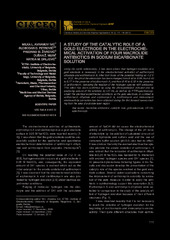Microencapsulation of Flavors in Carnauba Wax
Аутори
Milanović, JelenaManojlović, Verica

Lević, Steva

Rajić, Nevenka

Nedović, Viktor

Bugarski, Branko

Чланак у часопису (Објављена верзија)
Метаподаци
Приказ свих података о документуАпстракт
The subject of this study is the development of flavor wax formulations aimed for food and feed products. The melt dispersion technique was applied for the encapsulation of ethyl vanillin in wax microcapsules. The surface morphology of microparticles was investigated using scanning electron microscope (SEM), while the loading content was determined by HPLC measurements. This study shows that the decomposition process under heating proceeds in several steps: vanilla evaporation occurs at around 200 degrees C, while matrix degradation starts at 250 degrees C and progresses with maxima at around 360, 440 and 520 degrees C. The results indicate that carnauba wax is an attractive material for use as a matrix for encapsulation of flavours in order to improve their functionality and stability in products.
Кључне речи:
microencapsulation / carnauba wax / flavors / ethyl vanillin / TG-DSCИзвор:
Sensors, 2010, 10, 1, 901-912Издавач:
- MDPI, Basel
Финансирање / пројекти:
- Интеракција имобилисаних ћелија, ткива и биолошки активних молекула у биореакторским системима (RS-MESTD-MPN2006-2010-142075)
- COST actionEuropean Cooperation in Science and Technology (COST) [865]
DOI: 10.3390/s100100901
ISSN: 1424-8220
PubMed: 22315575
WoS: 000273999800053
Scopus: 2-s2.0-77953663688
Институција/група
Tehnološko-metalurški fakultetTY - JOUR AU - Milanović, Jelena AU - Manojlović, Verica AU - Lević, Steva AU - Rajić, Nevenka AU - Nedović, Viktor AU - Bugarski, Branko PY - 2010 UR - http://TechnoRep.tmf.bg.ac.rs/handle/123456789/1685 AB - The subject of this study is the development of flavor wax formulations aimed for food and feed products. The melt dispersion technique was applied for the encapsulation of ethyl vanillin in wax microcapsules. The surface morphology of microparticles was investigated using scanning electron microscope (SEM), while the loading content was determined by HPLC measurements. This study shows that the decomposition process under heating proceeds in several steps: vanilla evaporation occurs at around 200 degrees C, while matrix degradation starts at 250 degrees C and progresses with maxima at around 360, 440 and 520 degrees C. The results indicate that carnauba wax is an attractive material for use as a matrix for encapsulation of flavours in order to improve their functionality and stability in products. PB - MDPI, Basel T2 - Sensors T1 - Microencapsulation of Flavors in Carnauba Wax EP - 912 IS - 1 SP - 901 VL - 10 DO - 10.3390/s100100901 ER -
@article{
author = "Milanović, Jelena and Manojlović, Verica and Lević, Steva and Rajić, Nevenka and Nedović, Viktor and Bugarski, Branko",
year = "2010",
abstract = "The subject of this study is the development of flavor wax formulations aimed for food and feed products. The melt dispersion technique was applied for the encapsulation of ethyl vanillin in wax microcapsules. The surface morphology of microparticles was investigated using scanning electron microscope (SEM), while the loading content was determined by HPLC measurements. This study shows that the decomposition process under heating proceeds in several steps: vanilla evaporation occurs at around 200 degrees C, while matrix degradation starts at 250 degrees C and progresses with maxima at around 360, 440 and 520 degrees C. The results indicate that carnauba wax is an attractive material for use as a matrix for encapsulation of flavours in order to improve their functionality and stability in products.",
publisher = "MDPI, Basel",
journal = "Sensors",
title = "Microencapsulation of Flavors in Carnauba Wax",
pages = "912-901",
number = "1",
volume = "10",
doi = "10.3390/s100100901"
}
Milanović, J., Manojlović, V., Lević, S., Rajić, N., Nedović, V.,& Bugarski, B.. (2010). Microencapsulation of Flavors in Carnauba Wax. in Sensors MDPI, Basel., 10(1), 901-912. https://doi.org/10.3390/s100100901
Milanović J, Manojlović V, Lević S, Rajić N, Nedović V, Bugarski B. Microencapsulation of Flavors in Carnauba Wax. in Sensors. 2010;10(1):901-912. doi:10.3390/s100100901 .
Milanović, Jelena, Manojlović, Verica, Lević, Steva, Rajić, Nevenka, Nedović, Viktor, Bugarski, Branko, "Microencapsulation of Flavors in Carnauba Wax" in Sensors, 10, no. 1 (2010):901-912, https://doi.org/10.3390/s100100901 . .


